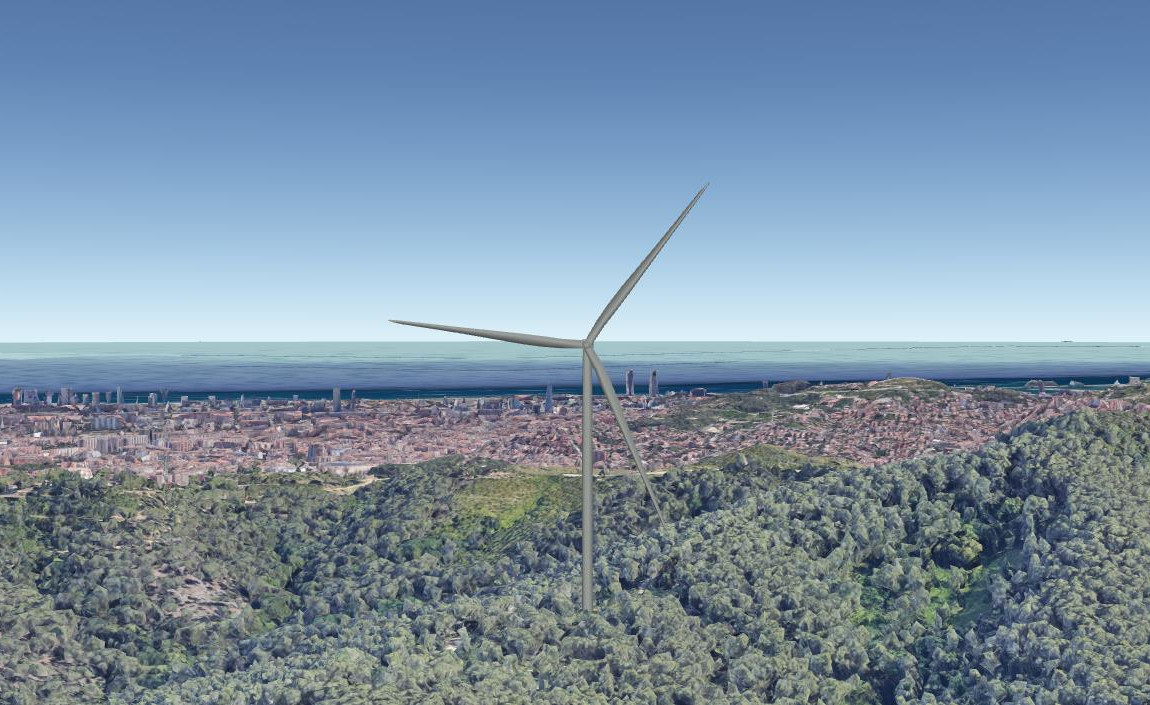Windmills in Barcelona? Group hopes to collect €12m for cooperative eco-friendly project
Two turbines could be installed in Collserola within 5 years, but legal problems and social opposition threaten proposal

Generating wind energy for Barcelona… from Barcelona. This is the aim of a group of entrepreneurs who are trying to collect €12 million from the public for an unprecedented project: installing windmills inside the Catalan capital within five years, or even "three if we are optimistic," promoters say.
Their plans, unveiled on Thursday, is to erect two 115-meter high windmills in Barcelona's northern nature park, Collserola, which would supply 8,800 households with green energy.
The project is called 'Viure de l'aire BCN,' using the literal meaning ('live out of the air') of a Catalan phrase used to describe people who intend to make a living without working.
The association wants to set up a cooperative eco-friendly project in which those who contribute now to make it happen would see their share of the electricity generated in return, thus lowering their electricity bill.
If the project went ahead, these windmills would be the first to be installed within the city limits and would be owned by the people who contributed to the €12 million.
"Barcelona is not a place with especially good conditions to put forward a wind project because the amount of energy we get is not ideal to install windmills," said Jordi Ferrer, a leading member of the Viure de l'Aire association. "Yet, we believe that this project is feasible, and can give a boost and help launch similar projects in the rest of the country, he added.
Indeed, raising awareness of the climate emergency is one of their main aims, therefore they want to install them in a place easy to see from anywhere in the city – similarly to the telecommunications tower in Collserola, from which the turbines would be close. "We will not place the windmills in a hidden place, but to become an iconic element in our skyline," said Ferrer.
Installing windmills in a natural park not easy
Yet, putting a new manmade object in the landscape of the Collserola natural park will not be easy. During the presentation, the entrepreneurs already anticipated some hurdles before it can come true, such as the fact that the hills are protected and these windmills cannot be installed as of now.
In order to navigate through these legal problems, they committed to lobbying so that the law "is more flexible" and reminded that the approach of the 2019 Catalan climate change law is to install wind farms as close as possible to the place where the generated energy will be consumed.
Also, they reminded that the European Commission acknowledges that a large number of areas where wind farms can be installed are part of natural parks and that "they want to analyze case by case."
"We think it is not reasonable to veto the windmills from the beginning," said Ferrer.
Indeed, according to the association, both Barcelona's local council, and the Collserola natural park authority have been positive about the plans.
Potential incompatibilities with the telecommunications tower, administrative obstacles and gathering the €12 million are seen as other potential issues.
Potential social opposition
Another possible problem the project will have to overcome is potential opposition from the public in Barcelona, considering that the greener part of their landscape will be altered.
Indeed, a number of wind farms trying to be developed across Catalonia are finding staunch opposition from locals whose concerns include a change in the views they have.
According to Viure de l'Aire, some of the groups against windmills elsewhere have a good impression of their plans, because their main argument is usually the fact that windmills are being installed in rural Catalonia, very far from where the energy will be consumed, unlike the structures intended for Barcelona.
Check out the episode of Filling the Sink, the Catalan News podcast, on the local opposition to wind farms across Catalonia published in April, including the controversy of a project off the Costa Brava:
How much do I need to pay to contribute?
"The reduction in the bill will depend on how much money you invest," said Jordi Ferrer, one of the members of the association. "It is like paying for your electricity bill for the upcoming ten years in advance," he said.
The website of the group shows an example for which a family that uses electricity, central heating and a car usually needs 20,950 kWh every year – with 4,954 kg of CO2 emissions –.
Their investment to get this energy through the windmills in Barcelona would have to be €14,660, which would be enough to cover all those expenses for the "over 20 years" that the turbines last, and without any emission – 20 years of a €100-electricity monthly bill would already cost €24,000.
The information on how to get involved can be found at https://viuredelairebcn.cat/